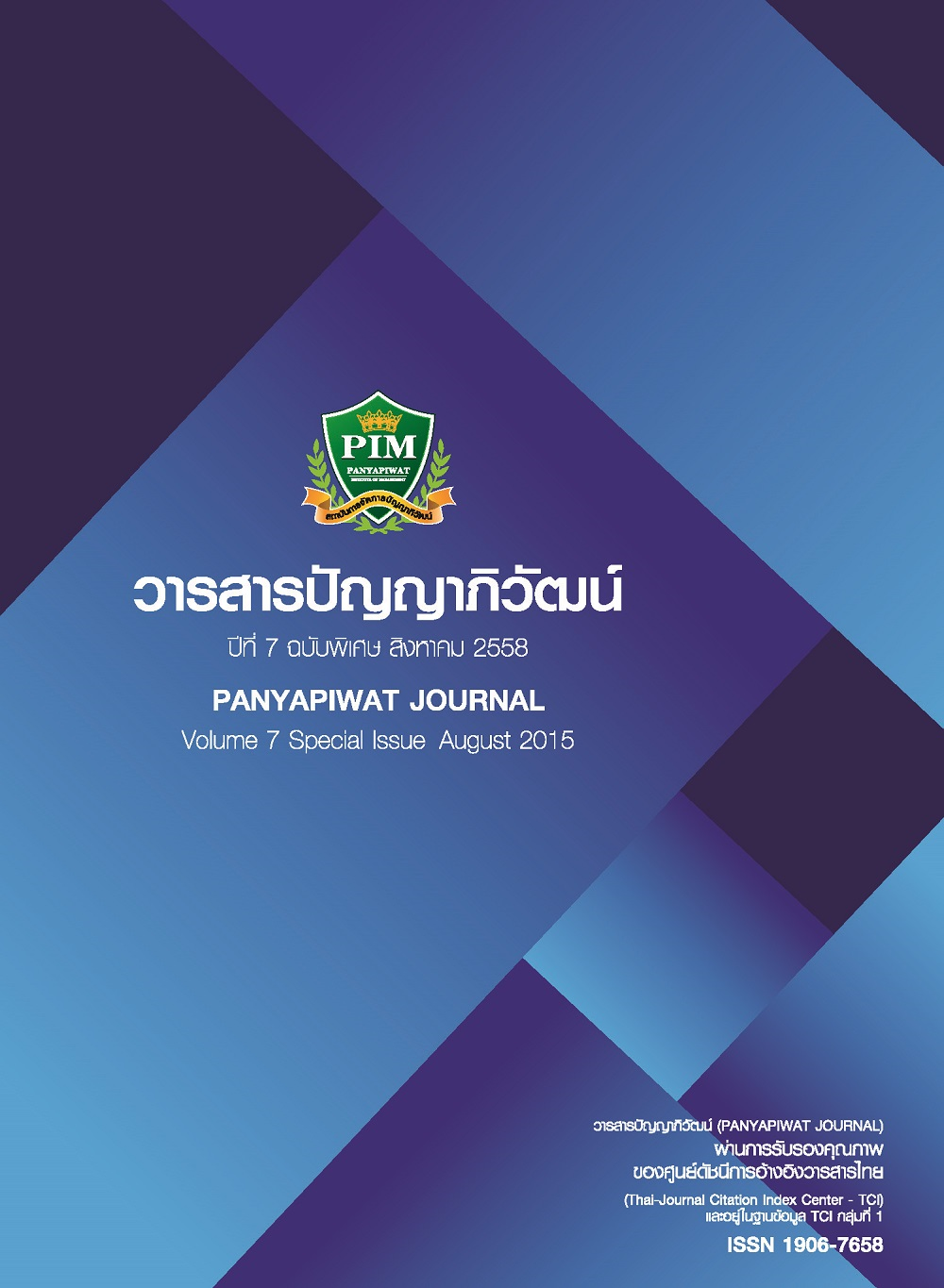สื่อ-ผู้คน: การส่งความฝัน ความหวัง และอนาคตในวิถีญี่ปุ่น
Main Article Content
บทคัดย่อ
ภัยธรรมชาติอาจจะถือได้ว่าเป็นเหตุการณ์ที่ใกล้ชิดกับวิถีชีวิตของชาวญี่ปุ่นมาช้านาน อันเป็นผลจากที่ตั้งและสภาพภูมิประเทศของญี่ปุ่นนั้นเอง คนญี่ปุ่นต้องเผชิญกับภัยธรรมชาติในหลายรูปแบบ ที่สำคัญคือ ภัยจากแผ่นดินไหว เมื่อ ค.ศ. 2011 เกิดเหตุการณ์แผ่นดินไหวครั้งใหญ่ทางภาคตะวันออกของญี่ปุ่นมีผู้เสียชีวิตเกินกว่าหมื่นคน รวมทั้งมีบ้านเรือนพังเสียหายจำนวนมาก ทำให้มีผู้อพยพอีกหลายแสนคน ชาวโลกรับรู้เหตุการณ์และเรื่องราวที่เกิดขึ้นผ่านสื่อต่างๆ ซึ่งมีวิธีการนำเสนอในหลากหลายรูปแบบและหลากหลายมุมมอง
สื่อของญี่ปุ่นไม่ได้นำเสนอเฉพาะภาพ เรื่องราว หรือความรู้สึกที่มีต่อเหตุการณ์หรือความสูญเสียเท่านั้น จากข่าวที่ได้นำมายกเป็นตัวอย่างครั้งนี้ ได้นำเสนอภาพและบทสัมภาษณ์หนุ่มสาว กับสถานที่ที่มีความผูกพันประทับอยู่ความทรงจำ พร้อมกับคำบอกเล่าเส้นทางอนาคตที่เลือกไว้ ทำให้มองเห็น “ลักษณะเฉพาะ” ของคนญี่ปุ่นได้ชัดเจนยิ่งขึ้น ไม่ว่าจะเป็นเรื่องของความอดทนไม่ยอมแพ้ต่อโชคชะตา ความรักความผูกพันต่อท้องถิ่น ความเชื่อมั่นในพลังและจิตวิญญาณของตนเอง รวมทั้งการใช้ชีวิตอย่างมีสาระ
วิธีการนำเสนอข่าวไม่เพียงจะสะท้อนให้เห็น “ความมีสาระ” ของคนหนุ่มสาว แต่ยังสะท้อนให้เห็น “ความมีสาระ” ของสื่อญี่ปุ่นด้วยเช่นกัน “สื่อ” สามารถเลือกเรื่องและวิธีนำเสนอได้อย่างมีสีสัน มีคุณค่า ภาพ เรื่องราว อีกทั้งคำพูดสำคัญของคนต้นเรื่องที่สื่อดึงออกมานำเสนอได้ส่งพลังสร้างกำลังใจให้แก่ผู้อ่านอีกทางหนึ่งด้วย
Natural disasters have probably been considered as an event connected to the Japanese way of life for a long time due to its location and topography. The Japanese are exposed to various types of natural disasters including earthquake, the most common destructive event. In 2011, the Great East Japan Earthquake killed more than ten thousand people, destroying houses and leaving hundreds of thousands evacuated. The world has been recognizing the event and its stories through media presenting in a variety of styles and perspectives, but the interesting and seemingly distinctive one is the Japanese media presentation. A fascinating example is how Asahi newspaper of Japan presented a special scoop This scoop doesn’t only provide pictures, stories or feelings towards the event or loss, but it also gives pictures and interviews about their impressive places, as well as the talks given about the future paths of their choices. The interview article makes it more evident to the "characteristics" of Japanese people like a virtue of extreme patience, community ties, beliefs in power of human spirit as well as the worthiness of life.
News release method doesn’t only reflect the "worthiness" of youths, but it also reflects the "worthiness" of the Japanese media. The "media" well selected the scoop and method to present the lives of these youths in a lively, valuable way. The pictures, stories and important voice of message deliverers that the media released also give encouragement to readers. The occurrence mentioned above, both the role of media and people, could answer the question that the Japanese have been able to overcome several disasters with the power of strength from personal accountability of each individual.
Article Details
“ข้าพเจ้าและผู้เขียนร่วม (ถ้ามี) ขอรับรองว่า บทความที่เสนอมานี้ยังไม่เคยได้รับการตีพิมพ์และไม่ได้อยู่ระหว่างกระบวนการพิจารณาลงตีพิมพ์ในวารสารหรือแหล่งเผยแพร่อื่นใด ข้าพเจ้าและผู้เขียนร่วมยอมรับหลักเกณฑ์การพิจารณาต้นฉบับ ทั้งยินยอมให้กองบรรณาธิการมีสิทธิ์พิจารณาและตรวจแก้ต้นฉบับได้ตามที่เห็นสมควร พร้อมนี้ขอมอบลิขสิทธิ์บทความที่ได้รับการตีพิมพ์ให้แก่สถาบันการจัดการปัญญาภิวัฒน์หากมีการฟ้องร้องเรื่องการละเมิดลิขสิทธิ์เกี่ยวกับภาพ กราฟ ข้อความส่วนใดส่วนหนึ่งและ/หรือข้อคิดเห็นที่ปรากฏในบทความข้าพเจ้าและผู้เขียนร่วมยินยอมรับผิดชอบแต่เพียงฝ่ายเดียว”
เอกสารอ้างอิง
合田禄、伊藤和行. (2011). 孫よ、母よ...棺に300人安置、宮城・利府の体育館.朝日新聞デジタル. สืบค้นเมื่อ 18 มีนาคม 2011, จาก http://www.asahi.com/special/10005/TKY201103180550.html
倒れても生きる、咲く 津波で倒木のサクラ 宮城・名取. (2011). 朝日新聞デジタル. สืบค้นเมื่อ 19 เมษายน 2011, จาก http://www.asahi.com/special/10005/TKY201104180548.html
見市紀世. (2011). やっと卒業式 南三陸町の2小学校.สืบค้นเมื่อ 2 พฤษภาคม 2011, จาก http://www.asahi.com/special/10005/TKY201104290561.html
東日本大震災から3年 避難生活、今なお26万7千人. (2014). 朝日新聞デジタル. สืบค้นเมื่อ 11 มีนาคม 2014, จาก http://www.asahi.com/articles/ASG3B6QB4G3BUTIL04X.html
東日本大震災人的被害. (2013).ウィキペディア. สืบค้นเมื่อ 24 มกราคม 2013, จากhttp://www.shinsaihatsu.com/data/110311hito.html
東日本大震災3年 高3、夢へ針路をとれ. (2014). 朝日新聞デジタル. สืบค้นเมื่อ 12 มีนาคม 2014, จาก http://www.asahi.com/articles/ASG36771WG36UQIP036.html
被災地から. (2011). 朝日新聞デジタル. สืบค้นเมื่อ 1 เมษายน 2011, จาก http:// www.asahi.com/photonews/gallery/110317eq-1/20110330 TPHO0102 AGOC_650px.html
ชาวเน็ตฯ จีน ยกย่องวินัยฯ ญี่ปุ่นในยามวิกฤติ. (2554). ผู้จัดการออนไลน์. สืบค้นเมื่อ 17 มีนาคมเมษายน 2554, จาก http://www.manager.co.th/China/ViewNews.aspx?NewsID=9540000033065
ญี่ปุ่นจัดรำลึกวันครบรอบ 3 ปีเหตุแผ่นดินไหวและคลื่นยักษ์สึนามิ 2554. (2014). J-channel. สืบค้นเมื่อ 12 มีนาคม 2014, จาก http://www.j-channel.jp/th/japannews/5149-mk20140312-1
รวมภาพเหตุการณ์ คลื่นยักษ์สึนามิ และแผ่นดินไหว ที่จังหวัดมิยะงิ บนเกาะฮอนซู. (2004). สืบค้นเมื่อ 12 กุมภาพันธ์ 2015, จาก http://www.photoontour.com/events_html/ tsunami_japan/tsunami_hits_japan.htm
Translated Japanese References
Goda, R. & Ito, Y. (2011). 300 Corpses of Grandchildren, Mothers in Coffins at a Gymnasium in Rifu, Miyagi. Retrieved March 18, 2011, from http://www.asahi.com/special/10005/TKY201103180550.html [in Japan]
Even Fallen but still Alive, Blooming Sakura from the Fallen Tree after Tsunami. (2011). Asahi Newspaper Online. Retrieved April 19, 2011, from http://www.asahi.com/special/10005/TKY201104180548.html [in Japan]
Mishi, K. (2011).The 2nd Year Elementary School Graduation Ceremony in Minamisanriku. Asahi Newspaper Online. Retrieved May 2, 2011, from http://www.asahi.com/special/10005/TKY201104290561.html [in Japan]
,000 People, Refugee Life after 3 Years of the Great East Japan Earthquake. (2014). Asahi Newspaper Online. Retrieved March 11, 2014, from http://www.asahi.com/articles/ASG3B6QB4G3BUTIL04X.html [in Japan]
Human Suffering in the Great East Japan Earthquake. (2013). Wikipedia.Retrieved January 24, 2013, from http://www.shinsaihatsu.com/data/110311hito.html [in Japan]
The 3rd Year High School Students on their Selected Paths to Dreams after 3 Years of the Great East Japan Earthquake. (2014). Asahi Newspaper Online. Retrieved March 12, 2014, from http://www.asahi.com/articles/ASG36771WG36UQIP036.html [in Japan]
From the Disaster Areas. (2011). Asahi Newspaper Online. Retrieved April 1, 2011, from http://www.asahi.com/photonews/gallery/110317eq-1/20110330TPHO0102 AGOC_650px.html [in Japan]
Translated Thai ReferencesChinese
Netizens Praising Japanese Discipline during the Crisis. (2011). Manager Online. Retrieved April 17, 2011, from http://www.manager.co.th/China/ViewNews.aspx?NewsID=9540000033065[in Thai]
Japan Commemorating the 3rd Year Anniversary of Earthquake & Tsunami in 2011. (2014). Retrieved March 12, 2015, from http://www.j-channel.jp/th/japannews/5149-mk20140312-1 [in Thai]
The Picture Collection of Tsunami & Earthquake at Miyagi Prefecture on Honshu Island. (2004). Retrieved February 12, 2015, from http://www.photoontour.com/events_html/tsunami_japan/tsunami_hits_japan.htm [in Thai]


